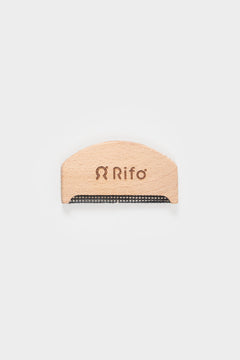The loom is an ancient tool, linked first of all to human civilization and then to the textile tradition.
The oldest traces of this invention date back to the Neolithic. In fact we have evidence of ancient looms thanks to cave paintings that show its use and the elementary technology, based on clay weights that keep the fibers in tension to be weaved.
Thousands of years of history have transformed the loom and the work that has developed around this tool, up to the contemporary looms with heddle. Thanks to this part of the loom it is possible to create fabrics, composed of warp - the threads stretched vertically - and weft - the threads that sliding horizontally are intertwined with the warp.
We have already talked about the sophisticated Jacquard loom in a previous article of our blog, but now we want to dedicate more space to the to the classic loom.
Talking about this object, for us at Rifò, means much more than just explaining how this tool works. In fact, it also means a piece of our city, and often also about our families.
In this article we will make you discover this tool, not only to give you a technical idea, but also to tell you how it marked and shaped the history of Prato.
The textile loom, what it is and how it works
Let's take a step back, what is exactly a loom with heddle like?
As we said before, the loom is used to weave the weft and warp of the fabric. The shuttle then carries the weft thread back and forth, which is pulled over to the fabric already formed through the comb.

The heddle (A and B) are frames, which contain the stitches where the warp threads pass. By raising and lowering the heddles, they allow the creation of the intertwining between the warp yarn and the weft yarn. There must be at least two healds, but it is also possible to have more, as in the case of the 8 heddle loom, used to weave the Rifò multi-use towels.
In general, the number of heddles varies according to the design of the yarn that make up the weave, the more heddles the frame will have, the more complicated the design of the weave can be.
The spread of looms in Prato families
The first mechanical heddle loom was installed in Prato around 1870, inside Lanificio Romei, a factory located in the Bisenzio river valley, on the Apennines overlooking the city. The company employed many workers and took care of the entire regeneration cycle of the wool fibers, from shredding, to spinning and finally weaving the new fabrics.
In the early 1900s, looms spread massively in the textile district of Prato, anyone who had a little place and could afforded it, bought a loom and worked near the house thanks to small orders for other entrepreneurs. Alternatively, it was the committent that supplied the frame to the craftsmen, which could work from his own place.
In the garages and in the sheds of all sizes, an economy of micro craftsmen and family businesses was born in Prato. Each of them was responsible for a small piece of what today defines a supply chain. The loud noise of the looms was the soundtrack of the city. A working swarm that populated the streets of the city with long pieces of fabrics.
The deafening noise of the looms spread throughout the city accompanies the citizens for most of the 20th century. Then the micro-enterprise system collapses, because of the need of a larger and more structured production.
Nevertheless we found an article pubished in 1997 on the newspaper Unità, that reports that out of the 310 thousand inhabitants of the Pratese textile district, there are an estimated 16 thousand weaving workers and 18 thousand looms, about 6 looms per 100 inhabitants.
Cinema references to the loom: "Madonna che silnzio c'è stasera"
There are many cinema references, which testify how the loom has marked the history of Prato. This is the case of the film Madonna che silenzio c'è stasera, directed by Francesco Ponzi, with a young Francesco Nuti, who is looking for work in Prato and soon meets the looms. Through a funny story, the loom is seen as a monstrous device, responsible for accidents at work and also for the inevitable loss of hearing for the weavers.
Loom and upcycled fabrics: Rifò's experiments
Through the heddle loom we can produce most of the fabrics used today, from technical ones with synthetic materials, up to woolen cloth, with patterns and colored drawings.
We at Rifò could not help but exploit a tradition and know-how present in Prato for over a century. So we started our experimentation with weaving from upcycled yarns, designing a recycled denim fabric and the colorful multi-use towels and the fancy shawls.
Being made up of shorter fibers, the upcycled yarn is weaker, which is why we had to prevent the yarn from breaking during the weaving phase.
For the upcycled denim denim fabric we therefore used a double yarn, twisted with 2 strands, to prevent too frequent breakage of the thread.

For Rifò towel, we have laid out a draft on the warp, an imperceptible layer of sticky substance removed during the finishing phase, which makes the yarn more resistant and has allowed processing with the mechanical loom.
To conclude
Wefts, warps, stories of men and women, of technologies, of optimization, of the work of arms but above all of the head. What we are most passionate about in Rifò is to enter the sheds where these stories still survive to tell you.

We do it through our products, so that you can become passionate about what you buy, because every detail could opens up a world for you.
Do you have someone in your family who works or has worked with looms as well?
Tell us in the comments!








